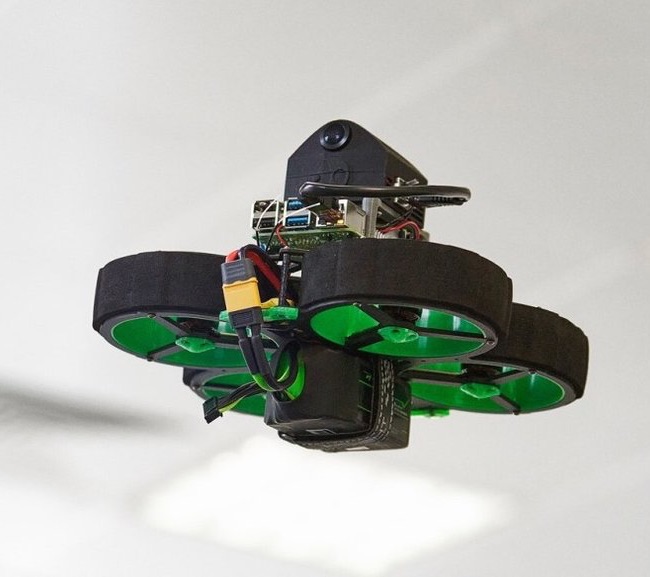This blog post was originally published at Opteran Technologies’ website. It is reprinted here with the permission of Opteran Technologies.
Opteran enables robust, fast, GPS free, verifiable autonomy for aerial systems, at previously unimaginable size, weight (~30g), power (~3W) and hardware costs using consumer 2D cameras
Today we’re happy to share a first glance at our ready for air solution, having integrated the Opteran Development Kit (ODK) onto our new Green Hornet aerial drone platform. Yesterday, at the Science Museum in London we introduced our approach to an audience of technologists, academics and investors for the first time as we build towards the full reveal of the platform in Spring 2022.
Why are we showcasing on an aerial autonomy platform? It is well-known that it is an expensive business building a commercial UAV due to the need for costly sensing and navigation equipment. “Lightweight” is not a term we hear too often about such drones, which require x3 redundancy in order to operate. The reality is that to operate safely they require more sensing, more weight, leading to shorter operational time and more batteries.
On top of this it is a really expensive business simulating 1000s of hours of flight time to ensure test coverage. Then if you’ve employed deep learning in critical navigation and obstacle avoidance tasks there’s the challenge of data curation for more testing and maybe a whole bunch of synthetic data creation and testing just to be sure, you are sure that the system is sure that it’s surely not wrong.
In contrast, a honey bee can fly for miles to forage for nesting sites, return to the existing nest and never lose its way, and then explain, with a simple dance, to fellow bees how to repeat that same route. This led us to ask, ‘Why not turn to nature for a far more efficient, elegant solution?’
While our nature-inspired autonomy solution is general purpose, available for all autonomous platforms on the ground or in the air, it is no understatement to say that we see a significant opportunity in commercial aerial drones. Air is one sector where a lot of our customers face challenges and the Size, Weight and Power (SWaPs) of Opteran Natural Intelligence provides an effective solution. On an Unmanned Aerial Vehicle (UAV) it is critical to manage weight and power consumption added to the airframe to avoid a significant drag on performance and increasing costs.
The robustness and efficiency of Opteran Natural Intelligence to see, sense, direct and decide are key advantages compared to competitor approaches when it comes to operating a UAV. If you are a fast-moving aerial vehicle then slow, error-prone processing can be disastrous, especially when you consider how important safety is for certification of aerial drones using autonomy. Importantly, Opteran Natural Intelligence moves away from the ‘black box’ complexity of deep learning models, as it is inspired by the far more effective and optimised autonomy solution that nature has developed over hundreds of millions of years. Having studied insects, we have identified how they use techniques such as Optic Flow to navigate safely and efficiently along a route. We have translated this understanding into algorithms that offer a much more transparent and safer way to deliver autonomy, verified through our advanced Hardware in the Loop and physical testing processes.
With 4π fully stabilized vision emulating the super-wide Field-of-Vision (FoV) and high-temporal resolution of insects we’ve been able to scale the SWaPs right down onto a reference Green Hornet drone whilst enabling it with Visual Inertial Odometry (VIO), collision prediction and place recognition algorithms enabling safe GPS-free exploration and navigation, obstacle avoidance and a completely diverse solution for Inertial Navigation System (INS) redundancy to prevent those unpleasant prop smashing events. The Opteran ODK runs as fast as your fastest cameras, is as light as 30g, and consumes under 3 watts. This is significantly less mass and energy consumption for aerial autonomy compared to photogrammetry approaches, and unlike deep learning-based models which lack robustness it does not require extensive and expensive training.
Opteran, Green Hornet and some of our key personnel feature in this film from UKRI that was premiered yesterday at a reception we hosted in the Science Museum, London. We showed Green Hornet and our ground-based platform Hopper, and were very excited by the reaction to this next generation autonomy technology.
Green Hornet is a reference implementation to showcase the low SWaPs advantage and there were a lot of interesting discussions at the event about how the technology could be applied to open up a wide range of new use cases, including a virgin territory of fully-autonomous sub 250g UAVs.
That said, given how cost effective the platform is, a number of people we spoke to quickly understood a clear use case for Opteran Natural Intelligence to be added alongside existing autonomy solutions to improve and enhance their reliability for regulatory compliance. We are busy with commercial UAV vendors integrating into more complex platforms where safety and diversity in autonomous operation is as critical as low cost load, operating with and without GPS in difficult outdoor and indoor environments.
Why not check out this video we’re releasing today of Green Hornet and get in touch if you want to discuss how Opteran Natural Intelligence could be integrated with your autonomous vehicle or robot. In the video we demonstrate our proposition including collision avoidance, navigation, and higher autonomy functions in a small, low power form factor. With the arrival of Green Hornet, we can confidently say we are delivering a breakthrough for autonomy applications, both air and ground-based, which previously would not have been feasible. Welcome to the future of autonomous machines! Welcome to a world of ‘Natural Intelligence’ for machines.
Dr Alex Cope
CTO and co-founder, Opteran Technologies


